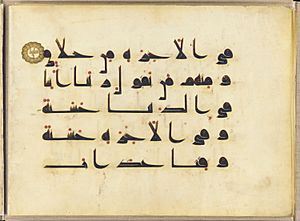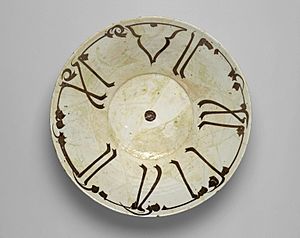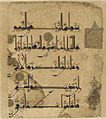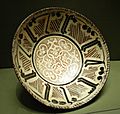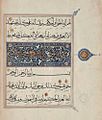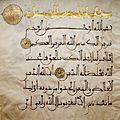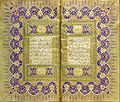Islamic calligraphy facts for kids

Islamic calligraphy is a beautiful art form of handwriting. It uses the Arabic alphabet and other alphabets that come from it. This art is found in many places, including Arabic, Persian, Ottoman, and Indian calligraphy. In Arabic, it's called khatt Arabi, which means "Arabic line" or "design."
This art is very important in Islamic culture. It's often used for writing parts of the Qur'an, which is the holy book of Islam. While pictures of people and animals are not usually shown in Islamic books to avoid idolatry, artists found a clever way around this. They would use tiny writing to create shapes and images. Calligraphy was seen as a very valuable art. An old Arabic saying even says, "Purity of writing is purity of the soul." This shows how much they respected this art.
Islamic calligraphy is not just for religious texts. Like all Islamic art, it's used in many different ways. Calligraphy is so common in Islamic art because writing and written words are very central to Islam. It's even said that the Islamic prophet Muhammad once said, "The first thing God created was the pen."
Islamic calligraphy grew from two main styles: Kufic and Naskh. There are many different versions of these styles. Also, some regions developed their own unique ways of writing. Today, Arabic and Persian calligraphy are even part of modern art. This started after countries in the Middle East became independent. There's also a newer style called calligraffiti, which mixes calligraphy with graffiti.
Contents
The History of Islamic Calligraphy
For hundreds of years, the art of writing has been a key part of Islamic art. The main ideas for Islamic calligraphy started in Baghdad. This city was the center of the Islamic empire for a long time. From there, the art spread far and wide, reaching places like India and Spain.
Calligraphy on Coins and Textiles
Calligraphy was even used on coins. Starting in 692, Islamic leaders changed the coins in the Near East. They replaced Christian pictures with Islamic phrases written in Arabic. This was especially true for gold coins. These coins often had quotes from the Qur'an written on them.
By the 900s, the Persians, who had become Muslim, started weaving Arabic writing into beautiful silk fabrics. These textiles with Arabic text were so special that Crusaders brought them back to Europe as treasures. One famous example is the Suaire de Saint-Josse. It was used to wrap the bones of a saint in France.
Learning the Art
Because Islamic calligraphy is so respected, most artists follow examples from famous calligraphers. This is true for religious works. In the Islamic tradition, calligraphers went through a lot of training. They studied their teacher's examples for a long time. Only after this training could they become certified as master calligraphers.
Main Styles of Calligraphy
Islamic calligraphy has many different styles. Each style has its own look and history. Let's explore some of the most important ones.
Kufic Script
Kufic is the oldest form of Arabic writing. This style uses straight and sharp lines. It looks like an older script called Nabataean. Early Kufic had about 17 letters. It did not have dots or other marks to help with pronunciation. These marks were added later in the 600s. They helped people read the Qur'an better. This increased the number of Arabic letters to 28.
Kufic script is thought to have started around the late 600s in a city called Kufa, in Iraq. That's where it gets its name. Over time, Kufic developed many different types. Some were flowery, some had braids, and some were square. Because of its straight and neat look, Kufic was often used for carving on stone and on coins. It was the main script for copying the Qur'an from the 700s to the 900s. By the 1100s, the more flowing Naskh style became more popular for everyday use. However, Kufic continued to be used for decoration.
There were no strict rules for Kufic script. The only common thing was the angular, linear shapes of the letters. Because early Kufic wasn't standardized, it looked very different from one region to another. Some forms were very square, while others were very decorative.
A common type is square Kufic, also known as banna'i. This style is still popular in modern decorations today. Sometimes, decorative Kufic writing was copied in Europe during the Middle Ages and Renaissance. This was called "pseudo-Kufic." Westerners might have thought these scripts were from the time of Jesus. So, they used them to show early Christians.
Naskh and Thuluth Scripts
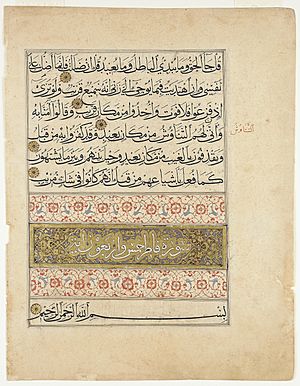
Cursive writing styles were used alongside Kufic. They were often used for everyday writing. As Islam grew, a new script was needed. A clear cursive style called Naskh appeared in the 900s. The word Naskh means "copying." It became the standard for writing books and manuscripts. This script is the most common style. It's used in the Qur'an, official papers, and personal letters. It also became the basis for modern Arabic printing.
Rules for Naskh were set by Ibn Muqla (886–940 A.D.). Later, Abu Hayan at-Tawhidi (died 1009 A.D.) made them even better. Ibn Muqla is often called the inventor of Naskh. However, it's now thought that his student, Ibn al-Bawwab, might have created it. Still, Ibn Muqla did create clear rules for how letters should be shaped. He used the letter 'alif' as a guide for height and the dot as a basic measurement.
Thuluth Script
Thuluth script was developed in the 900s. Over time, Ottoman Calligraphers like Mustafa Râkim and Shaykh Hamdallah made it even better. Letters in Thuluth are tall and have wide spaces between them. The name "Thuluth" means "one third." This might refer to the height of the letters, which is one-third of the 'alif. Or it could mean the pen used for vowels is one-third the width of the pen for letters.
- Reqa' is a handwriting style similar to Thuluth. It appeared in the 900s. It has simple shapes with short strokes. Yaqut al-Musta'simi was a calligrapher who used this style.
- Muhaqqaq is a grand style used by skilled calligraphers. It's a type of Thuluth. Muhaqqaq was seen as one of the most beautiful and hardest scripts to write. It was often used during the Mamluk era. Later, it was mostly used for short phrases, like the basmallah.
Regional Calligraphy Styles

As Islam spread, the Arabic script went to many different places. Each region developed its own special style. From the 1300s onwards, other cursive styles appeared in Turkey, Persia, and China.
- Maghrebi scripts grew from Kufic letters in North Africa (the Maghreb) and Spain (al-Andalus). Maghrebi scripts are usually written with a pointed pen. This makes the lines a consistent thickness. There are different types of Maghrebi, like the flowing mujawher and the formal mabsut.
- Sudani scripts developed in West Africa. They are a type of Maghrebi script.
- Diwani is a flowing style of Arabic calligraphy. It was created during the early Ottoman Turks' rule in the 1500s and early 1600s. Housam Roumi invented it. It became very popular under Süleyman I the Magnificent (1520–1566). Letters are often close together, and lines go upwards from right to left. Larger versions, called djali, are filled with many dots and marks. This makes them look very compact. Diwani is hard to read and write because it's so stylized. It became the perfect script for court documents. This kept them secret and stopped people from forging them.
- Nasta'liq is a cursive style. It was first made to write the Persian language for poems and other non-Qur'anic works. Nasta'liq is thought to have come from Naskh and an older Iranian script called Ta'liq. It quickly became popular in South Asia. The name ta'liq means "hanging." This refers to how the lines of text look slightly sloped. Letters have short vertical strokes and wide, sweeping horizontal strokes. The shapes are deep, hook-like, and have strong contrast. A version called Shikasteh was created in the 1600s for more formal uses.
- Sini is a style developed in China. It's greatly influenced by Chinese calligraphy. It uses a horsehair brush instead of the usual reed pen. A famous modern calligrapher in this tradition is Hajji Noor Deen Mi Guangjiang.
Modern Calligraphy Art
In recent times, artists in North Africa and the Middle East have turned Arabic calligraphy into a modern art movement. This is known as the Hurufiyya movement. Artists in this style use calligraphy as a design element in their modern artworks.
The word hurufiyya comes from the Arabic word harf, which means "letter." In the past, this term had deep spiritual meanings in Sufism. It referred to an old system of ideas where letters were seen as important signs that shaped the world.
Hurufiyya artists mixed Western art ideas with their own culture and heritage. They combined Islamic visual traditions, especially calligraphy, with modern art styles. These artists wanted to find their own unique voice. They also aimed for an art style that went beyond national borders and showed a wider connection to Islamic identity.
The Hurufiyya art movement likely started around 1955 in North Africa with the work of Ibrahim el-Salahi. However, using calligraphy in modern art seemed to appear on its own in different Islamic countries. Artists often didn't know about other Hurufiyya artists' work. This led to different versions of the style in different regions. For example, in Sudan, artworks include both Islamic calligraphy and West African patterns.

The Hurufiyya art movement wasn't just for painters. It included artists working with different materials. For example, Mahmoud Taha, a ceramic artist from Jordan, combined traditional calligraphy with his pottery skills. The artist Shirin Neshat, though not part of Hurufiyya, uses Arabic text in her black-and-white photos. This creates interesting contrasts. In Iraq, the movement was called Al Bu'd al Wahad (the One Dimension Group). In Iran, it was known as the Saqqa-Khaneh movement.
Western art has also influenced Arabic calligraphy in other ways. One example is calligraffiti. This is when calligraphy is used in public art to share social messages or decorate buildings. Famous Islamic calligraffiti artists include Yazan Halwani in Lebanon, el Seed in France and Tunisia, and Caiand A1one in Tehran.
Gallery
Kufic
-
Maghrebi Kufic script in the 9th or 10th century Blue Quran
-
Under-glaze terracotta bowl from the 11th century Nishapur
Naskh and Thuluth
-
Naskh script in an early 16th-century Ottoman manuscript dedicated to Selim I
-
Thuluth script tile in Samarkand
-
Calligraphy of Ali decorating Hagia Sophia
Regional varieties
-
A Moroccan Quran in a mabsūt Maghrebi script
-
Surat Az-Zumar in an Andalusi script, from the Nasrid period in Al-Andalus
-
Mushaf al-Hadina, from the Zirid period in Tunisia, in a Kufic script
Modern examples
-
Muhammad calligraphy
-
Flag of the Islamic Emirate of Afghanistan 2001
-
The Word "Allah" written in the Form of Pigeon in Chota Imambara
Craft
Images for kids
-
Muraqqa script by Mehmed Şevkî Efendi of the two intro pages of the Holy Koran, Khalili Collection of Islamic Art


